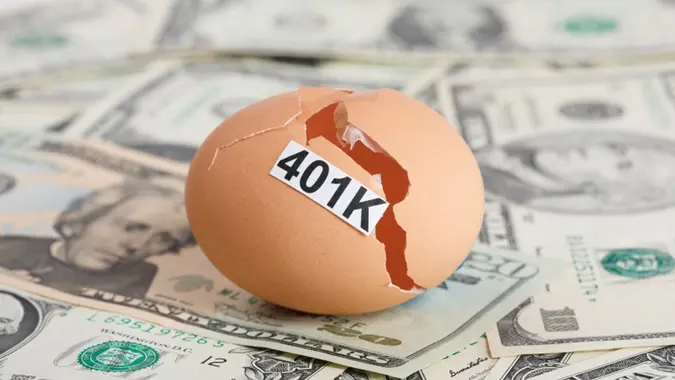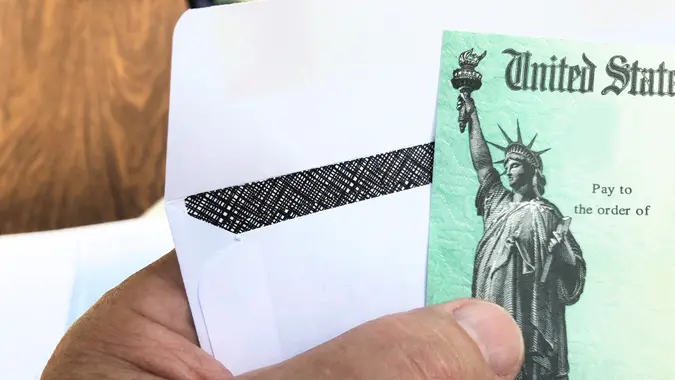How to Borrow From a 401(k)

Commitment to Our Readers
GOBankingRates' editorial team is committed to bringing you unbiased reviews and information. We use data-driven methodologies to evaluate financial products and services - our reviews and ratings are not influenced by advertisers. You can read more about our editorial guidelines and our products and services review methodology.

20 Years
Helping You Live Richer

Reviewed
by Experts

Trusted by
Millions of Readers
Many 401(k) plans allow you to borrow up to 50% of your vested balance or $50,000, whichever is less, and repay it within five years through payroll deductions. Loans are typically limited to one at a time, and the money you repay goes back into your own account with interest, though you’re essentially paying yourself back with after-tax dollars.
Still, borrowing against your retirement savings comes with trade-offs. If you leave your job or are terminated, the outstanding loan balance typically becomes due within 60 to 90 days, or it may be treated as an early withdrawal, subject to taxation and penalties if you’re under age 59½. You’ll also miss out on potential investment growth while the borrowed funds are out of the market.
Because the potential consequences are serious, borrowing from a 401(k) is not a decision to be taken lightly. We’re here to help you understand everything you need to know — from loan rules and repayment terms to the pros and cons — so you can decide whether this option makes sense for you.
What Is a 401(k) Loan?
A 401(k) loan lets you borrow from your own retirement savings, using your account balance as collateral. Unlike a bank loan, there’s no credit check and the money is usually available quickly if you need it.
It’s considered an option of last resort but it’s still better than an early withdrawal. As long as you repay on time, you won’t owe taxes or the 10% early withdrawal penalty that normally applies before age 59½.
Not every plan allows loans, but when they do, you can usually borrow up to 50% of your vested balance or $50,000, whichever is less. Repayment is required within five years and is typically taken straight from your paycheck. The interest rate is often tied to the prime rate, and the good news is that the interest goes back into your account.
The main drawback? While the money is out of your 401(k), it’s not invested, so you could miss out on growth. And if you leave your job, you’ll usually have to pay the loan back quickly or risk it being treated as a taxable withdrawal.
How to Borrow From Your 401(k) in 5 Easy Steps
If you’re considering taking out a 401(k) loan, follow these five steps to do it the right way.
- Check if your employer’s plan allows you to borrow against your savings.
- Confirm how much you can borrow. It’s usually the lesser of $50,000 or 50% of your vested balance.
- Apply through your plan administrator or online portal.
- Agree to the loan repayment terms, usually 5 years through automatic payroll deductions.
- Use the funds as needed and make timely payments to avoid taxes and penalties.
How Much Can You Borrow From a 401(k)?
Most plans that allow 401(k) loans cap the amount at the lesser of $50,000 or 50% of your vested account balance. For example, if you have $60,000 vested, you could borrow up to $30,000. If you have $200,000 vested, the cap is $50,000.
That said, not every plan is the same. Some may impose lower maximums, while others require a minimum loan amount (commonly $1,000). In rare cases, plans may also limit how often you can borrow or restrict the loan to certain uses, like buying a primary residence.
Because the rules can vary by employer, it’s always important to check your plan documents before assuming you can borrow the maximum allowed under federal guidelines.
How 401(k) Loan Repayment Works (And What Happens If You Don’t Pay It Back)
Most 401(k) loans must be repaid within five years, although plans often allow a longer term if the money is used to buy a primary home. Repayments are usually taken straight from your paycheck, which makes it easier to stay on track — but it also means less take-home pay, so you’ll want to plan your budget accordingly.
Missing payments can quickly create problems. If you fall behind, the unpaid balance may be treated as an early withdrawal, which means it will be taxed as ordinary income and, if you’re under 59½, hit with a 10% penalty. The same applies if you leave your job before the loan is paid off — you could be required to repay the entire balance within 60 to 90 days. If you can’t, the IRS treats the outstanding amount as a taxable distribution.
Advantages of Borrowing From Your 401(k)
Before taking out a 401(k) loan, it’s important to weigh the potential benefits against the risks. Here are some key pros and cons to consider.
Pros of Borrowing From a 401(k)
- No credit check required, and it won’t affect your credit score.
- Interest payments go back into your own retirement account.
- Quick access to cash compared to most other loan options.
Cons of Borrowing From a 401(k)
- Borrowed funds stop earning investment returns while they’re out of the market.
- If you leave your job, you may have to repay the loan in full within 60-90 days.
- Failure to repay on time can turn the balance into a taxable withdrawal, plus a 10% penalty if you’re under 59½.
Alternatives to Borrowing From Your 401(k)
Many experts recommend using 401(k) loans only as a last resort. Before you borrow against your retirement fund, consider the following alternatives:
- Personal loans
- Home equity loans or HELOCs
- Margin loans on taxable brokerage accounts
- Emergency savings
- Loans from friends or family
- Roth IRA contributions, which are withdrawable at any time without taxes or penalties
The Bottom Line on 401(k) Loans
Borrowing from a 401(k) should generally be a last resort. While it can give you fast access to cash without a credit check, it comes with real risks. The money you take out won’t be growing in the market, and if you default or lose your job, you may be forced to repay the full balance quickly, often within 60 to 90 days. If you can’t, the IRS treats the outstanding loan as a taxable withdrawal, plus a 10% penalty if you’re under 59½.
That said, if you’ve exhausted other borrowing options, a 401(k) loan is usually less damaging than an outright early withdrawal. Just make sure you understand the repayment terms, plan for the impact on your take-home pay, and stay current on payments to avoid taxes and penalties.
FAQ
- How much can I borrow from my 401(k)?
- In most cases, you can borrow up to 50% of your vested account balance, capped at a maximum of $50,000. Some plans may set stricter limits or require a minimum loan amount, so it’s important to check the rules of your specific plan.
- What happens if I leave my job with a 401(k) loan?
- If you leave your job — whether voluntarily or involuntarily — you may be required to repay the entire outstanding balance immediately or within a short timeframe, often 60 to 90 days. If you cannot repay it in time, the remaining balance will be treated as an early withdrawal, which means it will be taxed as ordinary income and, if you’re under 59½, subject to a 10% penalty.
- How long do I have to repay a 401(k) loan?
- The standard repayment period for a 401(k) loan is five years. However, if the loan is used to purchase a primary residence, some plans allow for a longer repayment term. Repayments are usually deducted directly from your paycheck, making them easy to stay current on but reducing your take-home pay.
- Is borrowing from a 401(k) better than a personal loan?
- Borrowing from a 401(k) doesn’t require a credit check, which can make it appealing if your credit score is low. However, unlike a personal loan, a 401(k) loan uses your retirement savings as collateral. This means you risk losing investment growth while the money is out of the account, and you could face steep taxes and penalties if you default or leave your job. For that reason, many financial experts consider a personal loan a safer option when available.
- Does borrowing from my 401(k) affect my credit score?
- No. A 401(k) loan does not require a credit check, nor does it appear on your credit report. Because of this, it has no direct impact on your credit score.
 Written by
Written by  Edited by
Edited by 

























